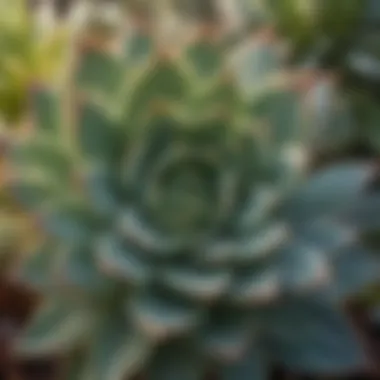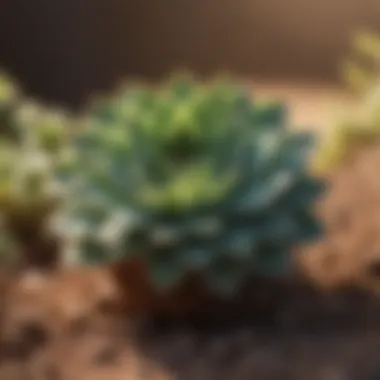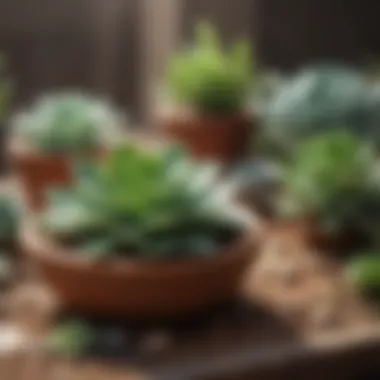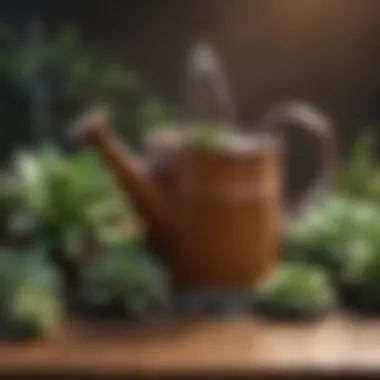When to Water Succulents for Optimal Health


Intro
Succulents are remarkable plants, appreciated for their unique appearance and low maintenance needs. However, understanding proper watering is essential for their survival. Too much water can lead to root rot, while too little can cause shriveling. The balance is fragile and requires attention to several factors.
Gardening enthusiasts, whether new or experienced, often ask: when is the right time to water succulents? This guide aims to shed light on that question. By exploring crucial aspects that influence watering patterns, this article seeks to empower gardeners to maximize the potential of their plants.
Key Insights and Trends
Understanding Environment
Environmental conditions play a significant role in determining when to water your succulents. Factors such as temperature, humidity, and light exposure direct the water needs of these plants. For example, succulents placed in brighter light will utilize moisture from the soil faster than those in shaded areas. Seasonal changes also impact water requirements significantly. During warm, dry months, succulents may need more frequent watering, whereas in cooler, humid months, they require much less.
Soil and Pot Size
The type of soil and pot size affects how quickly the soil drains. Well-draining soil mixes that include materials like perlite or pumice can aid in quick evaporation, making more frequent watering necessary. Conversely, small pots retain moisture longer. Pay attention to the container your succulent is in and adjust your watering technique accordingly.
Thirst Indicators
Succulents have distinct signals that indicate their thirst levels. Leaves may appear wrinkled or shrivelled when they need water. Alternatively, when overwatered, leaves can become mushy and discolored. Understanding these indicators is crucial to developing a successful watering schedule.
"Observing your plant closely can reveal much about its hydration status. Regular check ins will help you learn its behavior over time."
Practical Tips and How-To Guides
Step-by-step Watering Guide
- Check the Soil
- Water Thoroughly
- Allow Drainage
- Adjust Based on Season
- Insert your finger about two inches into the soil. If it feels dry, it's time to water.
- Water until excess flows out of the drainage holes. This ensures that the entire root system receives moisture.
- Never let the pot sit in a saucer of water. Excess moisture can lead to root rot.
- Watering needs will vary by season. Monitor the environment to adjust your routine.
Common Mistakes to Avoid
- Overwatering is the most common mistake made by succulent owners. Be cautious and patient during watering.
- Using non-draining pots can trap moisture, risking plant health. Always opt for pots with drainage.
By being attentive and utilizing these practices, gardeners can maintain healthy and thriving succulents. With this knowledge, the mystery of watering succulents can be solved effectively.
Preface to Succulent Care
Succulents have become increasingly popular among homeowners, interior design enthusiasts, and gardening aficionados. These plants are admired not only for their unique aesthetics but also for their relative ease of care. However, despite their hardiness, understanding the intricacies of succulent care is essential to ensure their longevity and vibrancy. This article aims to explore a crucial aspect of succulent maintenance: when to water these resilient plants.
The essence of succulent care lies in striking a balance between providing enough water and avoiding over-saturation. Succulents store moisture in their leaves, stems, and roots, which enables them to survive in arid conditions. This unique adaptation means that they require different watering practices compared to traditional houseplants. Therefore, recognizing when to water your succulents will not only enhance their health but also prevent common issues related to improper watering.
In this section, we will delve into the various factors that govern the watering schedules for succulents, including environmental conditions, species-specific needs, and common watering errors that even experienced gardeners can make. By becoming aware of these elements, readers can develop a more effective and informed approach to caring for their succulents.
"Understanding your plant's watering needs is crucial for its survival and growth."
Moreover, this comprehensive guide aims to empower both novice and seasoned gardeners with the knowledge necessary for nurturing thriving succulents. With a focus on observation and adaptability, maintaining a flourishing succulent garden can become an attainable goal for anyone interested in enhancing their home or garden.


Ultimately, the journey through succulent care will lead to a deeper appreciation for these remarkable plants, promoting a sustainable and fulfilling practice.
In summary, grasping the fundamentals of succulent care—especially concerning watering—is vital for promoting healthy growth and vibrant aesthetics. As we progress through the sections, readers will gain valuable insights and practical tips tailored to their watering routine.
The Anatomy of a Succulent
Understanding the anatomy of a succulent is fundamental when it comes to providing ideal care, especially in terms of watering. Succulents are unique plants, specifically adapted to thrive in arid environments. Their distinct structure allows them to store water, making them relatively low-maintenance compared to other plant species. Learning about their anatomy not only helps in recognizing when they need water but also in ensuring their general health and longevity.
Understanding Water Storage
Succulents have specialized tissues designed for water retention. Most notably, their leaves, stems, and sometimes even their roots, can store substantial amounts of water. This capability is crucial as it allows succulents to survive prolonged periods of drought. The thick and fleshy leaves are often the first indicators of a succulent's water reservoir. When these leaves appear plump and firm, it signifies that the plant is well-hydrated. Conversely, when they start to shrivel, it's a clear indicator that the plant requires water.
The internal structure of succulents has adaptations, such as the presence of a waxy cuticle on their surface. This cuticle helps to reduce water loss through transpiration, which is especially important in hot and dry conditions. Understanding these mechanisms can help gardeners gauge how often and how much to water their plants.
Photosynthesis and Water Needs
Photosynthesis is the process by which succulents convert light energy into chemical energy, using water and carbon dioxide. To maintain proper photosynthesis, succulents do require a balance between light, water, and nutrients. While succulents are highly efficient at utilizing water, they still have set needs that must be met to ensure their proper growth.
The water needs of succulents can vary significantly based on environmental conditions. For example, when introduced to ample sunlight, they tend to utilize water efficiently, requiring less frequent watering. Their metabolic rate increases with the light, driving photosynthesis and thus affecting their thirst.
It's essential for succulent owners to monitor flowering and growth patterns as indicators of their photosynthetic activity. During the active growing season, typically in spring and summer, they may need more water. However, during dormancy in winter, they significantly reduce their water needs as photosynthetic activity declines. Educating oneself on these aspects of succulents is vital in establishing a proper watering schedule and ensuring plant health.
Environmental Factors Affecting Watering
Understanding the environmental factors affecting watering is vital for the health of succulents. These plants thrive in specific conditions, and their watering needs can change based on varying environmental factors. Knowing how climate, light exposure, and humidity levels influence succulents will help ensure that you do not over or under-water them. This will lead to a healthier plant with vibrant leaves and a robust structure.
Climate Considerations
Climate plays a significant role in determining when and how often you should water your succulents. In hot and dry climates, the soil can dry out quickly, necessitating more frequent watering. Conversely, in cooler and humid regions, the soil retains moisture longer, requiring reduced watering frequency. It's crucial to observe local climate patterns, such as season changes, temperature, and rainfall.
Consider these points:
- Hot climates: Check the soil every few days during the peak summer months. Succulents may require watering once a week or even more often.
- Cold climates: In winter, reduce watering to once every few weeks. Background humidity will prevent rapid drying of the soil, allowing you to maintain moisture effectively.
Light Exposure Impact
The amount of light a succulent receives greatly affects its watering needs. Succulents exposed to full sunlight tend to utilize water more rapidly than those grown in shaded areas. An increase in light exposure speeds up photosynthesis, leading to quicker moisture depletion in the soil. For example:
- Full Sun: Aggressive watering may be needed weekly. Evaluate if the plant is showing signs of thirst, such as wrinkled leaves, which indicate a need for hydration.
- Partial Shade: Watering can be less frequent. The plants may require water only every two weeks, as they will draw moisture more slowly.
Humidity Levels and Succulents
Humidity is another vital factor that can affect watering schedules for succulents. These plants generally prefer low humidity environments. In high humidity, succulents retain moisture longer. Therefore, you should adjust your watering routine accordingly based on current humidity levels.
- Low Humidity: Frequent watering is essential. With dry air, the soil can dry out quickly, requiring more regular checks.
- High Humidity: Reduce watering significantly, as moisture will linger longer in both the soil and air. It's essential to monitor the plants closely to avoid rot from excess moisture.
Remember: The condition of your succulents can often serve as an indicator of environmental factors. Healthy succulents will display firm, plump leaves while those needing water may appear shriveled or dull.
Signs That Your Succulents Need Water
Recognizing when your succulents require water is a critical skill for any gardener. Observing the signs can help you maintain optimal health for these resilient plants. Watering at the right time ensures succulents thrive and avoids common issues like overwatering or underwatering. In this section, we will explore key indicators of moisture needs, ensuring you can understand the specific requirements of your succulents.
Leaf Appearance Changes


One of the most noticeable signs that succulents need water is their leaf appearance. Healthy, hydrated leaves are typically thick, firm, and plump. When succulents begin to dehydrate, these leaves may appear shriveled or wrinkled. Another indicator of moisture needs is leaf coloration, which can shift to a dull or paler shade.
The visual cues from your succulents can prevent severe water stress, enabling you to act promptly.
It is essential to inspect these leaves regularly. Consistent observation allows for timely interventions. If you notice leaves turning soft or mushy, this could be a sign of overwatering instead. Therefore, understanding how leaves respond to both excess and lack of water is key to successful succulent care.
Soil Moisture Indicators
The moisture level in the soil plays a significant role in determining when to water your succulents. Regularly monitoring soil moisture can prevent both overwatering and underwatering. Here are two effective methods to assess soil moisture:
Checking Soil Composition
Checking soil composition involves examining the soil's texture and condition. The composition should promote drainage since succulents do not like sitting in water. loose, well-draining soil typically contains materials like perlite or sand alongside regular potting mix. When you touch the soil, it should be somewhat dry a few inches down. If it feels damp, it's best to wait before watering again.
The key characteristic of checking soil composition is simplicity. It is a practical and popular choice for identifying moisture levels. However, it requires careful attention to ensure the soil remains suitable for growth. On the downside, this method may sometimes mislead if there is variance in soil compactness.
Using Moisture Meters
Using moisture meters can offer a precise measurement of the soil moisture levels. These devices are inserted into the soil to indicate moisture levels accurately. This method is beneficial for those who prefer a hands-off approach while keeping track of their plants' needs.
The unique feature of moisture meters is their ease of use. They can provide a quick visual indication of the moisture level. This advantage streamlines decision-making for watering. However, a disadvantage is that not all moisture meters are accurate, necessitating some research before purchase.
Overall, by understanding these signs, you can enhance the health of your succulents, thereby providing them with the best possible care.
Watering Techniques for Succulents
Watering techniques are an essential aspect of succulent care. The way you water these plants can significantly affect their health, growth, and appearance. Succulents have specific needs due to their unique structure and the environments from which they originate. Understanding the right methods can help avoid common watering mistakes and ensure your succulents thrive year-round. Choosing the best watering technique involves not only the method but also observing the individual needs of your plants.
Methodology of Deep Watering
Deep watering is crucial for succulents as it mimics their natural habitat. Succulents are adapted to survive arid conditions, and their roots need to reach moisture deep in the soil. When you apply water, doing so thoroughly encourages the roots to grow downwards. This process promotes a robust root system and enhances the plant's overall stability.
To practice deep watering:
- Water until it drains: Pour water generously at the base of the plant until you see it draining from the bottom of the pot. This ensures moisture penetrates deeply.
- Allow drainage: Never let succulents sit in standing water. Use pots with drainage holes to prevent water from accumulating, which can lead to root rot.
- Frequency: Allow the soil to fully dry out between watering sessions. This may take several days to weeks, depending on the environment.
Drainage Importance
Drainage plays an integral role in succulent health and is one of the considerations when selecting pots and soil. Proper drainage prevents water accumulation, a common cause of problems like overwatering and root rot. Here are some aspects of drainage to consider:
- Soil choice: Use a well-draining soil mix, often composed of sand or perlite alongside standard potting mix. This composition helps with aeration and drainage.
- Pot selection: Choose pots made from porous materials like terracotta. These materials help wick away excess moisture.
- Regular checks: Monitor the drainage holes regularly to ensure they are not blocked. Keeping the drainage clear aids in providing healthy conditions for your succulents.
Remember, the right watering techniques, paired with good drainage practices, can lead to beautiful and healthy succulents that will enhance your living space.
By mastering these watering techniques, you maintain the balance between dry and wet conditions that succulents require. This practice not only supports their health but also enhances their beauty, contributing positively to your gardening endeavors.
Seasonal Watering Adjustments
Adjusting your watering schedule based on the seasons is vital for the health of your succulents. Unlike many traditional houseplants, succulents have unique water needs that change with temperature, light, and humidity. Understanding these seasonal variations can enhance growth, improve resilience, and promote longevity. A thoughtful approach to watering throughout the year can prevent both overwatering and underwatering, common mistakes many plant owners make.
Summer Watering Practices
In summer, succulents enter a period of active growth. During this time, they typically require more water, but this does not mean excessive watering is advisable. Increased temperatures and longer daylight can lead to rapid evaporation, making moisture retention essential. Factors such as the specific species of succulent, potting medium, and local climate should influence your watering frequency.


- Watering Frequency: Generally, succulents will require watering approximately every 1-2 weeks during summer. However, always assess the soil moisture first. If it still feels damp, postpone watering to avoid root rot.
- Morning Watering: Watering in the morning is ideal as it allows any excess moisture to evaporate throughout the day. This reduces the risk of mildew and other diseases.
- Deep Watering Method: When watering, apply water until it starts to drain from the bottom of the pot. This ensures that the roots receive adequate hydration.
- Check Soil Condition: It is important to use well-draining soil to support healthy root growth and avoid whole plant issues. The soil should dry out almost completely between watering sessions.
Winter Dormancy Care
In winter, many succulents enter a dormant phase. During this period, their water requirements decrease significantly. Overwatering can lead to extreme stress or death from root rot. Recognizing the signs of dormancy is critical for their survival through the colder months.
- Decreased Watering Frequency: During winter, reduce watering to about once every month or even less, depending on the succulent variety. Always allow the soil to dry out completely before watering again.
- Avoid Cold Watering: It is best to use room temperature water for winter watering. Cold water can shock the roots, harming the plant.
- Placement Considerations: If succulents are kept indoors, observe their positioning. Succulents near windows may still receive light but will be influenced by draft and cold temperatures. This could require readjusting your watering schedule to maintain their health.
Succulents are robust plants, but they flourish with attentiveness and care. Adjusting watering habits according to seasonal changes ensures they remain vibrant and healthy.
The changes in your environment bring unique challenges and opportunities regarding care for succulents. Observing and adapting to seasonal needs can significantly impact the overall health of these resilient plants.
Common Watering Mistakes to Avoid
Understanding common watering mistakes when caring for succulents is crucial for their wellbeing. Watering, while a fundamental aspect of plant care, is often where many enthusiasts go wrong. These errors can lead to significant health issues or even death of the plants. Recognizing these mistakes fosters better decision-making and cultivates a sustainable gardening practice.
Overwatering Consequences
Overwatering is perhaps the most prevalent mistake in succulent care. Succulents are specially adapted to dry environments, storing water in their leaves and stems. When the soil remains consistently moist, it can lead to root rot, a serious condition where roots decay and cease to function properly. Symptoms of overwatering include yellowing leaves, mushy stems, and a foul odor coming from the soil.
To prevent overwatering:
- Choose the right pot: Always use pots with drainage holes to allow excess water to escape.
- Assess soil moisture: Check the top inch of the soil for dryness before watering.
- Adjust frequency: Water only when the plant shows signs of thirst, typically every couple of weeks in spring and summer. A good practice is to let the soil dry out completely between watering sessions.
Overwatering not only affects the individual plants but can also lead to can spread to nearby plants, potentially wiping out an entire collection.
Underwatering Effects
On the opposite end of the spectrum, underwatering can also severely affect succulent health. Despite their water-storing capabilities, succulents still require a certain level of hydration to thrive. Signs of underwatering can manifest as shriveled leaves and a general lethargy in growth. When underwatered, the plant's ability to photosynthesize and carry out essential functions diminishes.
To mitigate underwatering:
- Establish a schedule: Make a routine to check your plants regularly. A good rule is to water when the soil is dry to the touch.
- Use moisture meters: Consider investing in a moisture meter for a more accurate measurement of soil wetness.
- Environmental adjustments: If the air is exceptionally dry or you keep your plants in a sunny spot, they may require more frequent watering.
It is essential to note that while succulents can withstand dry spells, prolonged neglect will lead to irreversible damage.
"Care for succulents requires balance; too much or too little can harm their vitality."
By understanding the consequences of overwatering and underwatering, gardeners can better assess their practices and devise a suitable watering schedule tailored to their succulent's needs.
Culmination and Best Practices
Understanding the optimal watering schedule for succulents is vital in achieving their health and longevity. This section outlines essential points and practices that can be applied for the proper care of these unique plants. Mastering the watering habits can lead to an overall improved quality of life for the succulents, enhancing their resilience against pests and diseases. Following the strategies discussed throughout the article can help gardeners, both seasoned and novice, create an environment where succulents thrive. Gardening is both a science and an art, requiring attention to detail and understanding of the specific needs of the plants involved.
Summarizing Key Points
- Assess Environmental Factors: Always consider climate, light, and humidity of the area where the succulent resides. Different species have varying needs based on their origins.
- Watch for Signs: Look for indicators such as leaf shrinkage or soil dryness to determine when succulents need water. Regular observation is key.
- Seasonal Adjustments: Be aware that watering needs change with the seasons. In winter, for example, most succulents require significantly less water due to dormancy.
- Watering Techniques: Focus on deep watering practices that allow for thorough hydration without risking root rot. Ensure the potting medium has excellent drainage.
- Common Mistakes: Avoid the pitfalls of overwatering and underwatering. Both can lead to detrimental effects on the plant’s health and growth.
It is imperative to put together these elements to enable a sustainable and thriving environment for succulents.
Encouraging Consistent Observation
Observation is fundamental to successful succulent care. Take a few moments each week to inspect your plants. Check for changes in leaf color, texture, and overall appearance. This diligence provides insight into the water needs of your succulents.
- Regular Inspection: Determine if the plants are plump or shriveling. This visual assessment helps ensure that you respond timely to their needs.
- Monitoring Soil Conditions: Stick your finger into the soil. If it feels dry several inches down, it is time to water. Understanding the soil's moisture retention is critical to effective care.
- Using Tools: If available, consider using a moisture meter. This tool can make it easier to achieve accurate readings, ensuring the best watering practices.
"Consistent care and observation transform mundane gardening into a rewarding experience."
In summary, watering succulents may seem simple, but doing it correctly is paramount. Implementing these best practices will empower gardeners to cultivate a vigorous and thriving succulent collection.



